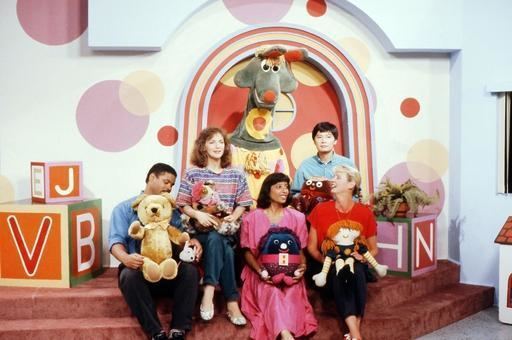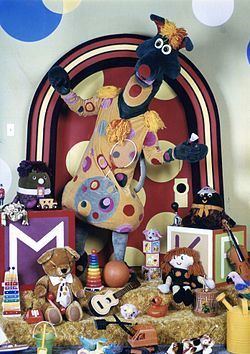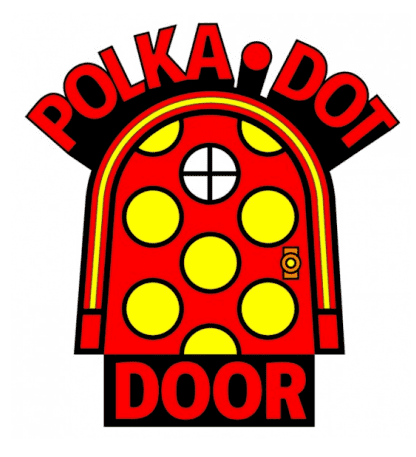7 /10 1 Votes
6.2/10 TV Awards Masterworks Honour | 7.8/10 IMDb Created by Peggy Liptrott First episode date 1971 | |||||||||||||||||||||||||||||||||
 | ||||||||||||||||||||||||||||||||||
Developed by Dr. Vera GoodPeggy LiptrottL. Ted ConeybeareMarnie Patrick RobertsDr. Ada SchermannDick DerhodgePat PattersonDodi Robb Written by Pat PattersonDodi RobbJed MacKayEmily HearnFran HandmanIan RitchieSusan MurgatroydNancy CrystalLori HauserAnne McCourtClive EndersbyMary MacKay-SmithCarmel SuttorL. Ted Coneybeare Directed by Peggy Liptrott (1971)Ian MorrisSusan Murgatroyd (1979–1984)David Moore (1983; 1985–1993)Douglas Williams (1987) Nominations Gemini Award for Best Performance in a Pre-School Program or Series Similar Polka Dot Shorts, Today's Special, Mr Dressup, The Adventures of Dudley, Finding Stuff Out | ||||||||||||||||||||||||||||||||||
1982 polka dot door carolann reynolds michael james partial episode
Polka Dot Door is a Canadian children's television series which was produced by the Ontario Education Communications Authority (later known as TVOntario) from 1971–1993. The series features two hosts who acknowledged and presented directly to the home viewing audience.
Contents
- 1982 polka dot door carolann reynolds michael james partial episode
- The polka dot door intro tv ontario
- Creation and history
- Producers musicians and hosts
- Format
- Characters and toys
- Legacy and awards
- One hour specials
- Polkaroo
- Parodies
- References

The content of the shows was generally geared towards education and creativity. Each week of episodes focused on a single theme with each weekday assigned a different "motif" in which the theme was explored in different ways (For example, Tuesdays were "Dress-Up Day" in which the hosts would use costumes to explore the theme).

One of the most well-known elements of the series was "Polkaroo": a mythical character whose name combines the words "polka dot" and "kangaroo". Normally played by the male host in costume, Polkaroo would appear to the female host to perform a pantomime; upon the second host's return, they would typically express disappointment when informed that they had once again missed Polkaroo. In earlier years, Polkaroo appeared just once per week on "Imagination Day", although due to the character's popularity additional appearances were added later in the show's run.

Another feature of the show was "looking through the polka-dot-door." This feature of the show, usually on "Finding-Out Day," was unique in that the camera would zoom in to a special dot on the door, which would open up to reveal a short educational film.

The polka dot door intro tv ontario
Creation and history

Polka Dot Door was created and developed by a team of employees from TVOntario, hired and led by original series producer and director Peggy Liptrott.
Significant contributors to the creation and development of the series in 1971 included executive producer Vera Good, who laid the conceptual foundation of the show, educational supervisor Marnie Patrick Roberts, educational consultant L. Ted Coneybeare, script writers and composers Pat Patterson and Dodi Robb, animator Dick Derhodge (who designed the familiar opening/closing animation) and Dr. Ada Schermann, a professor at the prestigious Institute of Child Study in Toronto who was consulted in the early stages of Polka Dot Door's development and is responsible for giving the show its name.
New episodes of Polka Dot Door originally aired on TVOntario Monday to Friday beginning in the fall of 1971 until the show's cancellation in 1993, with reruns running in constant rotation both on weekdays and weekends well into the 1990s.
The show itself was an adaptation of the BBC children's show Play School. Initially many aspects and concepts of Play School were licensed by TVOntario for use on Polka Dot Door, including designs of some of the stuffed animals used in the show (which were similar to those used in Play School as well as educational film inserts/segments which were shown to viewers "Through the Arched Window" on Play School and "Through the Polka Dot Door" on Polka Dot Door.
Robb helped distinguish Polka Dot Door as uniquely Canadian with her creation and addition of the iconic, mythical character Polkaroo, combining the show's title with the word kangaroo. Polkaroo would reprise his role every Thursday (Imagination Day), appearing to only one of the two hosts (the other dressing up and playing the role of Polkaroo). In the late-1970s, then-producer Coneybeare led negotiations to dissolve TVOntario's licensing agreement with Play School, freeing Polka Dot Door to be distinctively Canadian and adapt to include more Canadian educational content.
Robb and Patterson co-composed the memorable theme song that accompanied the opening/closing animation used for the series' entire run and wrote many of the early scripts and songs used in the series including "Imagine, Imagine", a song often used on Imagination Day with Polkaroo. Robb would go on to be the first-ever head of children's programming at CBC Television, where she would be immortalized for her contributions to Canadian children's television in the form of Muppet "Dodi" in Sesame Park, Canada's adaptation of Sesame Street.
Producers, musicians and hosts
During the course of the series' run, Polka Dot Door had three producers who significantly contributed to the development of the show: Original producer-director Peggy Liptrott (1971), L. Ted Coneybeare (1972–1984) and Jed MacKay (1985–1993). MacKay began as a writer and composer for Polka Dot Door in the 1970s. He went on to create and produce two multi-award winning series for TVOntario, Join In! and Polka Dot Shorts. The accompanying background music throughout the show was played "live to tape" by virtuoso Canadian pianists Herbie Helbig (1971–1984) and John Arpin (1985–1993).
Each episode of Polka Dot Door had two human hosts, always one man and one woman. There were more than 50 hosts over the course of the series. Each pair of hosts was contracted for one week's worth of episodes, with many hosts and pairs reprising their role over multiple weeks but not necessarily with the same co-host. Most hosts during MacKay's time as producer were contracted for two to three weeks worth of episodes (10–15), with the exception of Carrie Loring, Johnnie Chase and Cindy Cook, who hosted every year MacKay produced (1985–1993) as well as the two one-hour specials. Typically 25–35 episodes were produced every summer during the course of the series, depending on available funds in TVOntario's programming budget. Many aspiring Canadian actors and actresses got their start on Polka Dot Door and went on to do notable work in North American television, film, and theatre.
Below is an incomplete list of some of the people who hosted Polka Dot Door. The name in brackets is the producer whom the host worked with followed by the years in which the host hosted (when known):
In addition, many hosts worked on other educational shows produced by TVOntario, including Heather Conkie (Dear Aunt Agnes, Report Canada, Music Box, It's Mainly Music), Nerene Virgin (Today's Special), Nina Keogh (Readalong, Today's Special, Bookmice, The Magic Library) and Rex Hagon (The Science Alliance). Cindy Cook was the longest serving female host appearing on Polka Dot Door between 1981–1993, making her one of the most recognizable hosts from the series. She is also the only host to have worked with two producers of the show, first with Coneybeare (from 1981–1984) and then with MacKay (from 1985–1993).
Format
Polka Dot Door was taped and broadcast in 'weeks', five episodes a week that would feature the same two hosts each day. Each five-day week had a specific theme and emphasis. However, within in that theme, each day of the week had its own theme that was consistent throughout the entire series:
In order to create trust and familiar routines with young children, Polka Dot Door was scripted with specific 'events' that were particular to each day of the week:
Another regular event on Polka Dot Door was Storytime. Storytime happened everyday on the show, regardless of what "day" it was. This included the activity of the host teaching and telling the time on a large, oversized blue (later pink) grandfather clock and featured the appearance of a small stuffed animal appropriately named "Storytime Mouse". Often Storytime Mouse would be engaged in some activity related to that day's story.
Although Storytime happened once every day on Polka Dot Door, it was often at different, unpredictable times during the program. Whatever activity was happening on the show would be interrupted by a sequence of chimes indicating that it was time to tell the time together and hear a story. The hosts would stop whatever activity they were doing and go to the grandfather clock to tell the time and then read a story in an adjacent rocking chair specifically used for this purpose on the show. Helbig and Arpin would provide instrumental piano accompaniment, often accenting the moods and themes represented in the story being told.
Depending on the emphasis, there would be a "song of the week" that would often be reprised every day, helping viewers to solidify the emphasis of that week's theme. Many of the songs in the early years of the program were composed by the script writers themselves. When MacKay, an accomplished composer, took over as producer from 1985–1993, he composed many of the songs used in the series during that time.
Characters and toys
The hosts would lead young children in songs and stories, and interact with stuffed animal characters Humpty, Dumpty, Marigold, and Bear. These characters never spoke or moved; the hosts would let the audience know what they were saying, for example, one of the hosts would say "What's that Marigold? You would like..." In the 1980s, a stuffed cat named Minou joined the toys, which introduced viewers to simple words and phrases in French. On certain theme days the hosts would invite the audience to peer through the Polka Dot Door to witness an educational video of some sort, showing, for instance, how crayons are made.
Legacy and awards
In 2010, the Academy of Canadian Cinema and Television gave Polka Dot Door a Masterworks award, calling it a "groundbreaking children's educational series" that "changed the nature of children's television programming" and "impacted countless young Canadians and raised the international profile of the Canadian television industry."
One-hour specials
Only two one-hour specials have aired in the history of Polka Dot Door, these shows consist of five hosts (two male, three female) and the Polkaroo portrayed by unknown host.
Polkaroo's Birthday Party: This was used to commemorate the 20th anniversary of the Polka Dot Door, as well as cameos from other hosts in the past.
Polkaroo Goes To Camp: This was used to commemorate the finale of the series, this is also the only show in the history of Polka Dot Door not to have storytime.
Polkaroo
Each day's episode had a particular theme. Monday was "Treasure Day", Tuesday was "Dress-Up Day", Wednesday was "Animal Day", Thursday was "Imagination Day", and Friday was "Finding Out Day". On "Imagination Day", the character Polkaroo (sometimes referred to as "the Polkaroo") appeared. The actor playing Polkaroo donned a tall, green plush costume that resembled a kangaroo. In its mended, yellow and multi-coloured polka-dot muumuu, the creature spoke using various repeated exclamations of its own name accompanied by elaborate gestures. The meaning of this pantomime was to be guessed by the audience. This was usually followed by a song whose lyrics began "Imagine, imagine, you can imagine Polkaroo...". In the first two seasons, Polkaroo would appear to one of the hosts while the other host was absent for some reason. The co host would return upon Polkaroo's departure, habitually exclaiming, "The Polkaroo was here?!?And I missed him again?!?" Both hosts took turns as the Polkaroo. Starting in the third season, only the male host donned the Polkaroo costume.
In the late 1990s, TVOntario capitalized on the success of Polkaroo by placing him and the other animal characters, now also actors dressed in costumes, in a new series, Polka Dot Shorts, which also had its own catchphrase moment, as each episode included the unlikely discovery of a pair of polka dot shorts, leading to the exchange:
(Character): A great big pair of polka dot shorts?
Polkaroo: How did they get there?!
The Polkaroo costume as seen above and on the original series was handmade in Toronto by Tanya Petrova, an immigrant artist from Toronto who made brief appearances on numerous television shows from Mr. Dressup to The Steve Allen Show in the late 1960s to early 1970s. Petrova also created 24 puppets, including Charlie Horse and Lionel for Shari Lewis, as well as costumes for Ontario Place theme park, Eaton's (for example, Glump) and other events and attractions.
There were several other versions of the Polkaroo costume as well: the one with the long slender neck was built by Lorraine Cramp in 1982. She also made the Moose and Beaver costumes for Cucumber, the Sidney the Kangaroo costume for Math Patrol, and the Subterranean Monster costume for Mathmakers.
Parodies
The 1980s Canadian sketch-comedy show Smith & Smith, starring real-life husband and wife team Steve and Morag Smith, used to parody the Polka Dot Door with a recurring sketch called "The Kids Show", with male and female hosts who loathed each other and bickered their way through the sketch. The sketches also featured the "Jerkaroo", played by Steve Smith with a paper bag over his head.
The 1989 UK-Canada co-production EMU-TV featured a recurring parody called "The Door with Spots All Over It".
A Canadian sketch-type educational television show called Bod TV, which focuses on nutrition education and is also produced by TVOntario, has a parody of Polka Dot Door called Polka Dot House as one of its sketches. The sketch plays as a combination of the television show with reality television series Big Brother. In it, one of the hosts gets tired of Bear repeatedly making honey sandwiches for everyone day in day out, and schemes with Marigold to get Bear out of the kitchen so she can prepare a meal that provides a more balanced diet.
